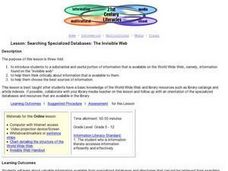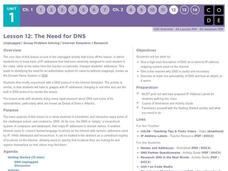Curated OER
Color Theory & Using Layers
Students investigate the color wheel theory and incorporate it into simple sketches on their handheld. The importance of the use of layering and the difference between primary, secondary, and tertiary colors is presented in this lesson.
Curated OER
Sea Changes: A New England Industry
Students conduct research in order to use primary and secondary sources. They interpret and analyze information from textbooks and nonfiction books for young adults, as well as reference materials, audio and media presentations, oral...
Curated OER
Everybody Needs a Little Sunshine
Three activities introduce upper elementary ecologists to photosynthesis and food webs. In the first, an experiment is set up to determine how plants respond to different types of light. In the second, they connect organism cards with...
Curated OER
Mapping Crime
Students use data on break and enter crime incidents to make a map that prompt discussion about the spatial location of crime in the city, why it would occur in those places, and how residents may reduce crime.
Curated OER
Math #3 Problems at the Ballpark
Students examine charts to answer questions. They develop their own database.
Curated OER
What Are My Chances?
Students calculate probability. In this lesson on probability, students use given data to calculate to chances of a given event occurring. Many of the calculations in this lesson are applicable to daily life.
Curated OER
The Vitruvian Theory - Does It Apply to You?
Students explore the concept of the Vitruvian theory. In this Vitruvian theory lesson, students collect data from their classmates about their arm span and height. Students compare their ratios of arm span to height with Leonardo Da...
Curated OER
Frieze Design in Indigenous Art
Students describe Frieze designs using the work of indigenous people. In this math lesson, students create 7 frieze designs using different patterns. They create one row of repeated art and repeat this 7 times over to show examples of...
Curated OER
Important Decisions Don't Just Happen! Using Data to Plan Your Services
Learners interpret statistics. In this data lesson, students examine and organize given data. They present the data in a grid format. Using the census data, learners determine the best location for a local business.
Curated OER
Not Everything is More Expensive
Students compare prices and determine percent increases and decreases of items in order to make wise purchases. In this percent increases and decreases lesson plan, students calculate the amounts based on grocery store ads.
Curated OER
Pumped Up Gas Prices
Learners calculate gas prices. In this transportation lesson, students tally the mileage and gas costs of their car for one months. They figure out how much was spent on gas and create a graph showing average gas prices over time.
Curated OER
Reading Help Wanted Ads
Students explore employment by analyzing the newspaper. In this wanted ads lesson, students identify the importance of job selection and job growth while reading entries in the wanted ads for employment opportunities. Students answer...
Curated OER
Searching Specialized Databases: The Invisible Web
Learners examine the useful information to be found on the "invisible web." They find the best sources of relevant information.
Curated OER
Careers Lesson: Budget Analysis
Ninth graders examine money management. They study percentages, inequalities, fixed and variable expense calculations in order to develop an understanding of how these concepts apply to budgeting a lifestyle for a specific career.
Curated OER
Simple Internet Searching - Lesson 1
Learners formulate strategies for locating information by identifying keywords and subject headings and by listing the steps to follow in carrying out information searches. They locate and access information from pre-selected sites.
Curated OER
Teaching With Documents Lesson Plan:Launching the New U.S. Navy
Students demonstrate understanding of the issues related to the creation and ratification of the United States Constitution and the new Government it established.
Code.org
The Need for DNS
That's one complicated address book! To understand the need for a system that keeps track of addresses, pupils trying to find the IP address of their classmates. Then individuals change their IP addresses, which leads to research about...
Louisiana Department of Education
Comprehensive Curriculum Social Studies (Grade 7)
US history from 1776 through 1877 is the focus of a comprehensive curriculum guide designed for seventh graders. Each of the seven units in the 102-page packet includes a list of guiding questions, grade-level expectations, links to...
Curated OER
Gopher, Part 2: Gopherin'
Students explore how to access a gopher site using a root menu. Several options are presented with their definitions and the fastest routes examined in this lesson. The lesson is designed for librarians with little or no net experience.
Curated OER
Phenomenology Lesson Plan #3: Content Part 2
Students examine magazine advertisements to identify how the product is being sold to the consumer. They work together in groups to respond to ads and explain why they are successful.
Curated OER
Phenomenology Lesson Plan #2: Content Part #1
Students examine different types of media. They identify the bias in film and share them with the class. They also examine their personal biases and write about them.
Curated OER
Phenomenology Lesson Plan #4: Character Part 1
Young scholars examine the way they react to characters and text. They write respones to different media tests. They are required to bring in a photograph and create a mini-biography for homework.
Curated OER
Phenomenology Lesson Plan #5: Character Part 2
Students examine the meaning of the word icon as it relates to media and pop culture. They watch and discuss film clips, write a mini-biography, take a Film Icon Quote quiz, and write a written response to the film clips.
Curated OER
Phenomenology Lesson Plan #1
Students approach media with a phenomenological criticism. They recongize biases that they have and where they have come from. They also identify biases in professional work.

























